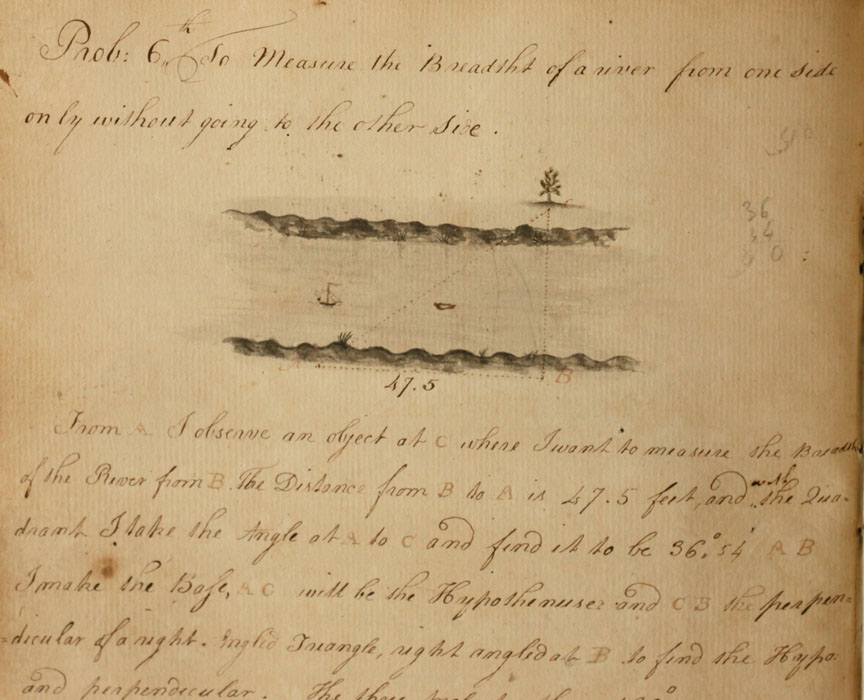- About MAA
- Membership
- MAA Publications
- Periodicals
- Blogs
- MAA Book Series
- MAA Press (an imprint of the AMS)
- MAA Notes
- MAA Reviews
- Mathematical Communication
- Information for Libraries
- Author Resources
- Advertise with MAA
- Meetings
- Competitions
- Programs
- Communities
- MAA Sections
- SIGMAA
- MAA Connect
- Students
- MAA Awards
- Awards Booklets
- Writing Awards
- Teaching Awards
- Service Awards
- Research Awards
- Lecture Awards
- Putnam Competition Individual and Team Winners
- D. E. Shaw Group AMC 8 Awards & Certificates
- Maryam Mirzakhani AMC 10 A Awards & Certificates
- Two Sigma AMC 10 B Awards & Certificates
- Jane Street AMC 12 A Awards & Certificates
- Akamai AMC 12 B Awards & Certificates
- High School Teachers
- News
You are here
Learning Geometry in Georgian England - Geometry and Measuring
Porcher’s book contained a very full course on geometry and measurement. The first half covered drawing lines, constructing plane figures, and inscribing and circumscribing figures around one another. It taught how to construct ‘proportional’ lines and a selection of other geometrical theorems such as this one.
To describe an Undecagon in a given circle.
Draw the semidiameter AB, divide it equally in two at G; from the points A and G with the same space describe the arches [arcs] GDI & AD; from I and the same space ID describe the Arch DO. The length GO will be an exact side of the Undecagon required.

Figure 2. Thomas Porcher constructs an undecagon.
This part culminated with Pythagoras’ theorem, and then the second half of the book turned to the art of measuring: measuring surfaces, measuring solids, and also plane trigonometry (that is, measuring triangles). Most of this was set out with quite abstract axioms, constructions and calculations, but towards the end there were some real-world problems: ‘To measure the Height of an accessible Tower’; ‘To measure the Distance of two places, neither of which is Accessible’; ‘To find the Diameter of the Earth from one observation’. But these, too, were exercises in trigonometry rather than practical surveying: once a few numbers had been put into the problem the rest was just calculation, using the methods set out earlier in the book. Sometimes there were explicit references to Euclidean theorems, which were invoked to justify certain steps in the calculation. The diameter of the earth was typical:
Let there be chosen a high hill AB near the sea shore, and let the observator [be] on the top of it, with in exact Quadrant divided into minutes and seconds by transverse Divisions, and fitted with a Telescope in place of the common sights …
The observer was to measure the angle between the horizon BE and the vertical AB, and the rest was then trigonometry – assuming the height of the hill was known – bringing in two Euclidean theorems concerning similar triangles.

Figure 3. Thomas Porcher’s Earth, with a high hill.
In this case the abstraction of the discussion was emphasised by the fact that no actual numbers were brought in: the outcome of the exercise was a method for finding the diameter of the earth, not the diameter itself. On the other hand, several of the problems did provide actual numbers, and thus helped Thomas Porcher practice not just Euclidean reasoning but also trigonometrical calculation.
To measure the Breadth of a river from one side only without going to the other side.
From A I observe an object at C where I want to measure the Breadth of the River from B. The Distance from B to A is 47.5 feet, and with the Quadrant I take the Angle at A to C and find it to be 36º54'. AB I make the Base, AC will be the Hypothenuse: and CD the perpendicular of a right-angled Triangle, right angled at B.
Simple trigonometry, relying on a printed set of tables, then made the breadth of the river 35.663 feet (with a rounding error in the third decimal place).

Figure 4. Thomas Porcher’s river.
Quite a lot of what was in Thomas Porcher’s book – particularly in its first half – was also to be found in Euclid’s Elements, that famous geometry textbook and one of the foundations of school and university geometry in the eighteenth century. Thomas Porcher’s book contained many propositions in a Euclidean style, and like Euclid’s Elements it began with definitions and axioms, some of them taken quite closely from the Greek master. Some of the propositions were based more or less closely on Euclid, too, like the construction of the equilateral triangle quoted above, or his version of Pythagoras:
In all right angled plain Triangles, the square of the longest side called the Hypothenuse, is equal to the sum of the squares of the 2 short legs.
But the structure of geometry had been completely re-thought compared with Euclid. Where did it come from? Not out of Porcher’s head, and probably not out of his teacher’s either. In places there are notes, now illegible, which might have recorded where the material came from. It’s quite possible that young Thomas copied his book from a teacher’s manuscript, or even from a printed book. But I think it’s more likely that he was drawing on more than one model, putting bits of them together and noting in the margin – sometimes – where the different sections came from.
Benjamin Wardhaugh (University of Oxford), "Learning Geometry in Georgian England - Geometry and Measuring," Convergence (August 2012), DOI:10.4169/loci003930




